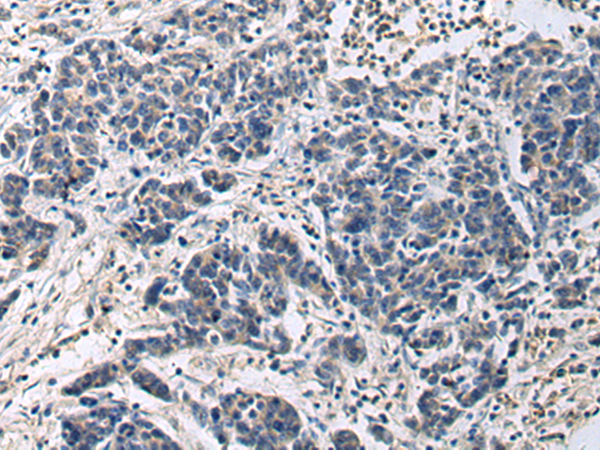
| WB | 咨询技术 | Human,Mouse,Rat |
| IF | 咨询技术 | Human,Mouse,Rat |
| IHC | 1/25-1/50 | Human,Mouse,Rat |
| ICC | 技术咨询 | Human,Mouse,Rat |
| FCM | 咨询技术 | Human,Mouse,Rat |
| Elisa | 1/5000-1/10000 | Human,Mouse,Rat |
| Aliases | HCNTF |
| Host/Isotype | Rabbit IgG |
| Antibody Type | Primary antibody |
| Storage | Store at 4°C short term. Aliquot and store at -20°C long term. Avoid freeze/thaw cycles. |
| Species Reactivity | Human, Mouse, Rat |
| Immunogen | Synthetic peptide of human CNTF |
| Formulation | Purified antibody in PBS with 0.05% sodium azide and 50% glycerol. |
+ +
以下是关于CNTF抗体的3篇参考文献及其摘要概括:
---
1. **文献名称**:*Ciliary neurotrophic factor prevents the degeneration of motor neurons after axotomy*
**作者**:Sendtner, M., et al.
**摘要**:该研究通过体内实验发现,CNTF能显著减少轴突切断后运动神经元的退化。研究中使用特异性中和抗体阻断CNTF活性,证实其在中枢神经损伤修复中的关键作用,为神经退行性疾病治疗提供依据。
---
2. **文献名称**:*CNTF is a survival factor for retinal ganglion cells after optic nerve lesion*
**作者**:Henderson, C.E., et al.
**摘要**:文章探讨了CNTF对视网膜神经节细胞的保护机制。通过抗体介导的免疫中和及Western blot分析,证明CNTF通过激活下游信号通路(如JAK/STAT)抑制视神经损伤后的细胞凋亡,提示其潜在治疗价值。
---
3. **文献名称**:*Characterization of the CNTF receptor complex using monoclonal antibodies*
**作者**:Davis, S., et al.
**摘要**:研究利用单克隆抗体解析CNTF受体复合物(CNTFRα/gp130/LIFRβ)的结构与功能。通过免疫共沉淀和阻断实验,揭示了受体亚基的相互作用机制,为开发靶向CNTF通路的抗体药物奠定基础。
---
**备注**:上述文献发表于20世纪90年代,反映了早期对CNTF及其抗体的功能探索。若需近年研究,建议在PubMed或Google Scholar中检索关键词“CNTF antibody”+“年份范围”。
Ciliary neurotrophic factor (CNTF) is a cytokine belonging to the interleukin-6 (IL-6) family, primarily expressed in glial cells of the central and peripheral nervous systems. It plays a critical role in supporting neuronal survival, promoting axonal regeneration, and maintaining the function of motor neurons. CNTF signals through a tripartite receptor complex involving CNTFRα, gp130. and LIFRβ, activating downstream pathways like JAK-STAT and MAPK. Dysregulation of CNTF has been implicated in neurodegenerative disorders, such as amyotrophic lateral sclerosis (ALS) and multiple sclerosis (MS), making it a potential therapeutic target.
CNTF antibodies are essential tools for detecting and quantifying CNTF in research and diagnostics. They are widely used in techniques like Western blotting, immunohistochemistry, and ELISA to study CNTF expression patterns, localization, and interactions in cellular and animal models. Monoclonal antibodies offer high specificity, while polyclonal antibodies can detect multiple epitopes, enhancing sensitivity. These antibodies have also been employed to explore CNTF's therapeutic potential, including its neuroprotective effects and role in metabolic regulation. However, challenges remain, such as optimizing antibody selectivity and minimizing cross-reactivity with related cytokines. Ongoing research aims to refine CNTF-targeting strategies for clinical applications, including regenerative medicine and treatment of neurodegenerative diseases.
×